Surveying the Common Core Battleground
In America’s public policy arena, Common Core debates box out practically every other type of policy discussion on K-12 education. This post sets out to address some basic questions about Common Core’s hardcore supporters and opponents. Who are they? Do these polarized groups have different backgrounds and perspectives? Where do the two groups stand on other topics in K-12 education and school choice?
Increasingly, governors and state lawmakers are being pressured to make public statements for or against Common Core. Other public leaders, commentators, and scholars—U.S. Secretary of Education Arne Duncan, former Gov. Jeb Bush, Randi Weingarten, Diane Ravitch, David Coleman, E.D Hirsch,Checker Finn, Anthony Cody, and Jay Greene.
Last year more than 70 business leaders placed a full page open letter in the New York Times supporting the Common Core. Months later, more than 100 Catholic scholars signed an open letter opposing the initiative.
Even pop culture icons are weighing in. As a recent POLITICO story documented, the list of celebrities sharing views on Common Core is longer than one might guess: there’s Louis C.K., Stephen Colbert, Matt Damon, Eva Longoria, Maya Angelou, Isaiah Thomas, John Legend, and most recently, Glenn Beck.
But where do ordinary Americans stand on Common Core? Are their opinions as intense as the sensational examples reported in the media? How do the strong supporters and strong opponents distinguish themselves from each other?
Based on the Friedman Foundation’s recent Schooling in America Survey, the early evidence indicates that Common Core’s hardened factions—whom I’ve called Champions and Dissidents—appear to separate themselves on at least three worldviews relating to K-12 education:
- the direction of K-12 education in the country,
- federal government performance in K-12 education, and
- standardized testing.
The two groups have been defined in a straightforward way: “Champions” are those who “strongly favor” Common Core—with provided context—in our survey. The “Dissidents” are those who “strongly oppose” the standards. In the remainder of this post, we are comparing only those two groups of respondents with informed, strongly-held positions on Common Core.
(As always with polling data and reporting subgroups, some caution should be taken when making comparisons of subgroups having smaller sample sizes—and hence, larger margins of error—than the total national sample.)
In the past year other national survey projects (EdNext/PEPG, AP/NORC, PDK/Gallup, and Achieve) have also asked questions about the Common Core. All of our surveys present items in different ways and with different ordering within respective questionnaires. Sample sizes and sample frames also can differ. None of these surveys, however, has specifically isolated and described the views of the subgroups most intensely in favor of or in opposition to Common Core. In fact, it would be very interesting—even with noted survey differences in mind—to see how Common Core’s Champions and Dissidents are represented based on others’ survey data.
So with that background and noting limits on interpretations, let’s highlight the distinctions between Common Core’s Champions and Dissidents. In all of the following snapshot comparisons, I consider the group-to-group differences (i.e. margins or gaps) as significant if we can be 90 percent confident of the difference—based either on statistical t-tests for comparing means or statistical z-tests for comparing population proportions.
Comparing the demographics of Champions and Dissidents indicates a number of population differences. We can be fairly certain that Common Core’s Champions are disproportionately more likely to be urban, Democrat, Latino, African American, and/or low-income. The Dissidents are more likely to be a school parent, Republican, and/or middle-class.
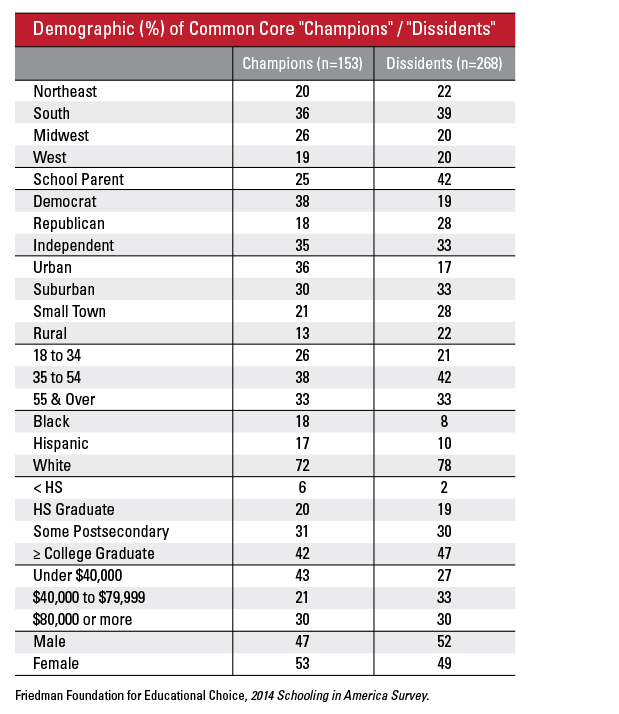
Nearly half of the Champions (47 percent) say American K-12 education is going in the right direction. This finding is in stark contrast to the much smaller proportion of Dissidents (16 percent) giving that assessment.
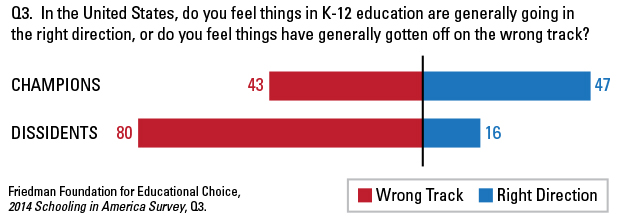
Just over half of the Champions (51 percent) give fair/poor ratings to the federal government. By contrast, nearly nine out of 10 Dissidents (89 percent) give similar negative ratings. Conversely, 9 percent of Dissidents give good/excellent ratings to the federal government. Approximately 43 percent of Champions rated the federal government positively.
This finding appears to coincide with Mike Petrilli’s on-the-road experiences, which he discussed in his July 31 post on the Fordham Institute’s blog. Dissidents see Common Core as a threat to federalism, improperly amplifying the role of the federal government in K-12 education.
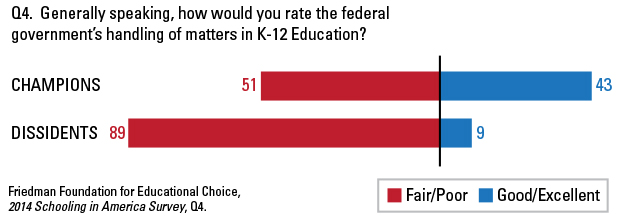
Dissidents are much more likely to say the amount of time spent on testing is “too high” (61 percent) compared with Champions (19 percent). Champions are more likely to say the amount of time spent on testing is “too low” (27 percent) compared with Dissidents (16 percent). The former is also more than twice as likely to say the amount of testing today is “about right.”
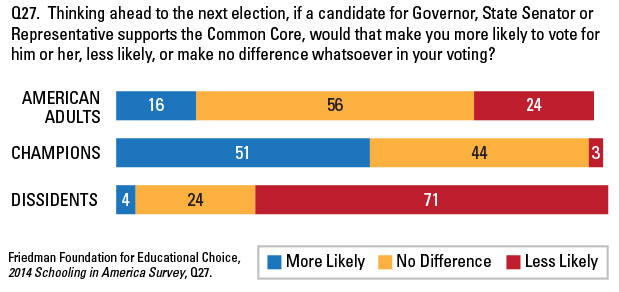
Majorities within both groups support school choice policies such as school vouchers (66 percent and 63 percent, respectively), charter schools (64 percent and 67 percent), ESAs (60 percent and 53 percent), and tax-credit scholarships (72 percent and 57 percent). When looking at the groups’ margins for those types of school choice policies, it is clear Champions and Dissidents are about equally likely to support school vouchers (+34 points vs. +28 points, respectively) and charter schools (+37 points vs. +40 points, respectively). Champions (+32 points) appear relatively more likely to favor ESAs than Dissidents (+14 points). Likewise, the former (+53 points) is more likely to support tax-credit scholarships than the latter (+24 points).
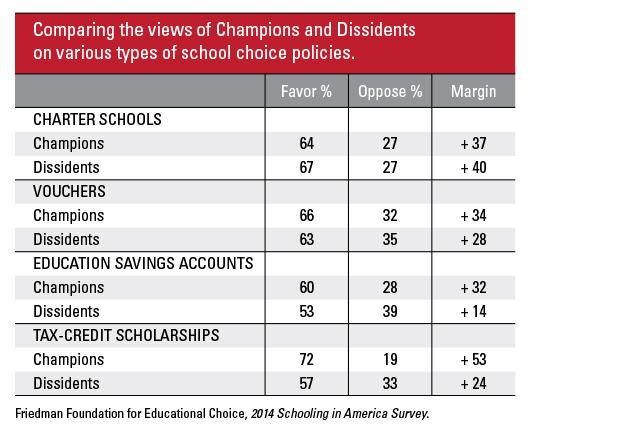
Indeed, implications of this survey data should be meaningful to anyone running for public office at the state or federal levels, or for those running campaigns this year. In the following chart we see that, as it would be expected, the Common Core issue should greatly influence the voting behavior of Champions and Dissidents. Compared with the general public, Champions are more likely to support a pro-Common Core candidate whereas Dissidents are more likely to vote against a pro-Common Core candidate (the 3 percent of Champions “less likely” and 4 percent of Dissidents “more likely,” which contradicts an earlier response, are assumed here to reflect statistical and/or survey artifacts, or what can be considered in the survey world as “noise”).
We did not survey “likely voters,” but it is reasonable to suggest that public opinion intensities, reflected by Champions and Dissidents, could translate to more active voting behavior. In other words, compared to their representation in our survey’s total sample, the two groups may represent larger proportions of the actual voter population. Exit polling this November will be the best way to empirically verify that possibility.
A few months ago, Louis C.K. tweeted on the Common Core: “Everything important is worth doing carefully.” When politicians, reformers, celebrities, and candidates engage the general public on Common Core, they should do so carefully. The reactions can be intense and likely revealing as to where Champions and Dissidents stand on the other important education issues.




